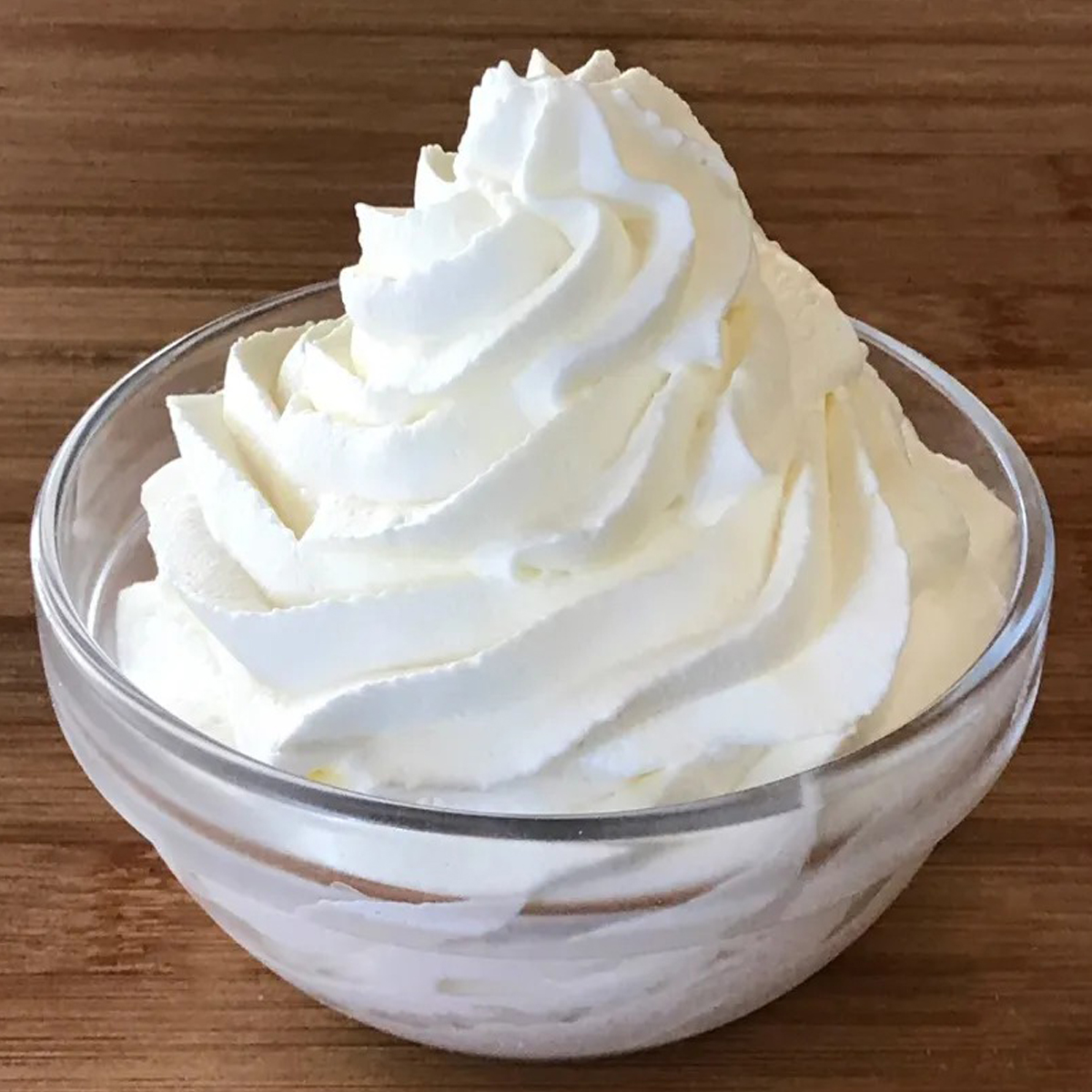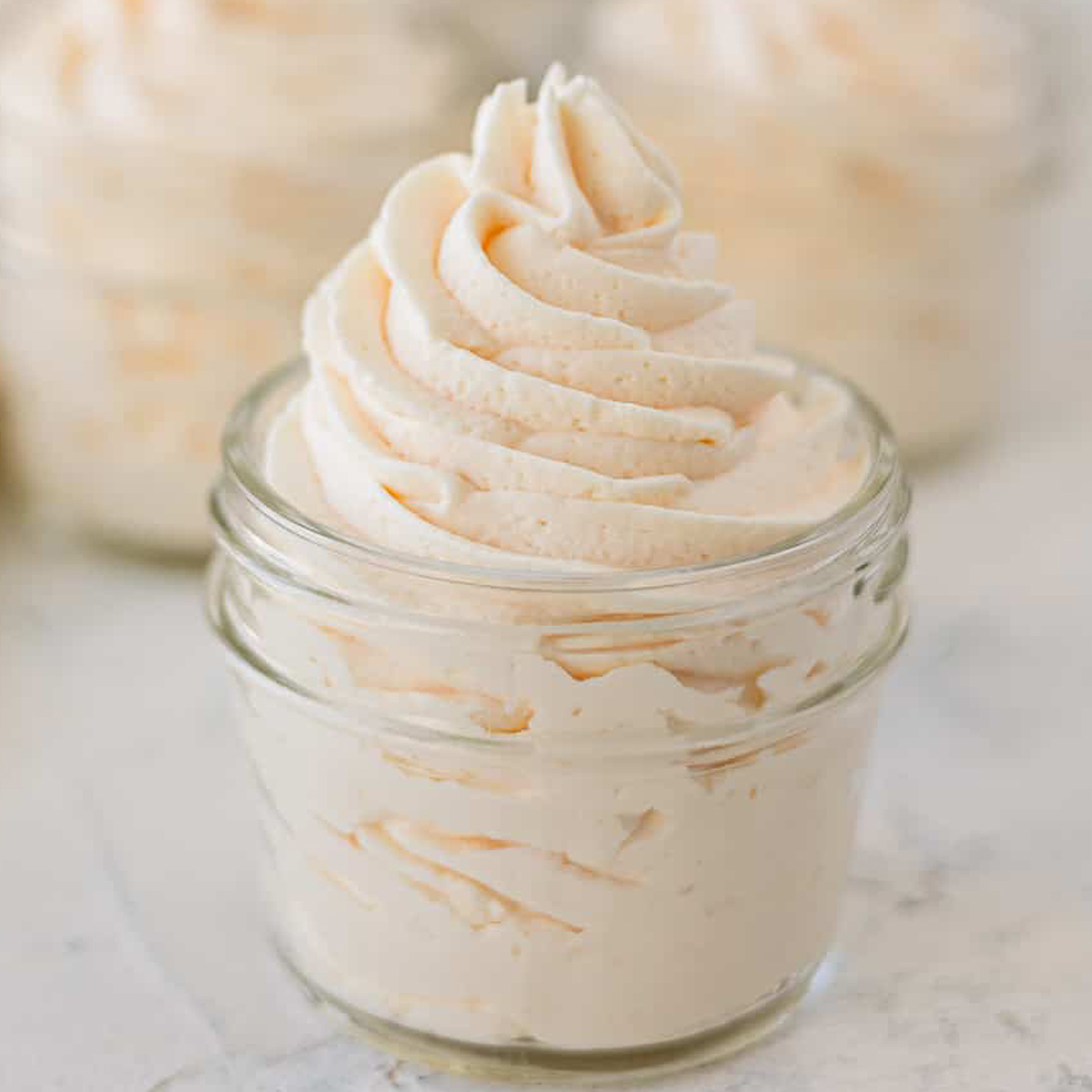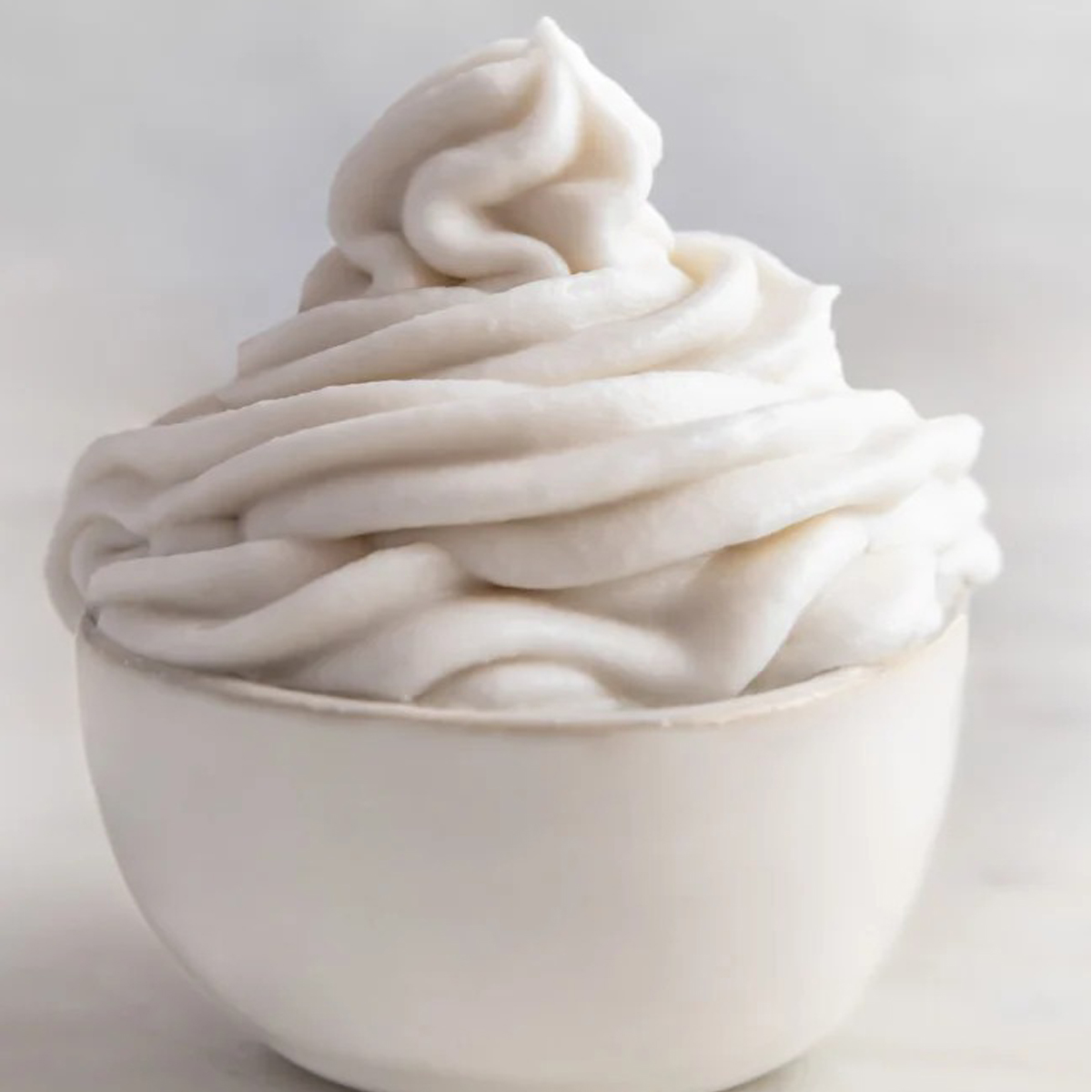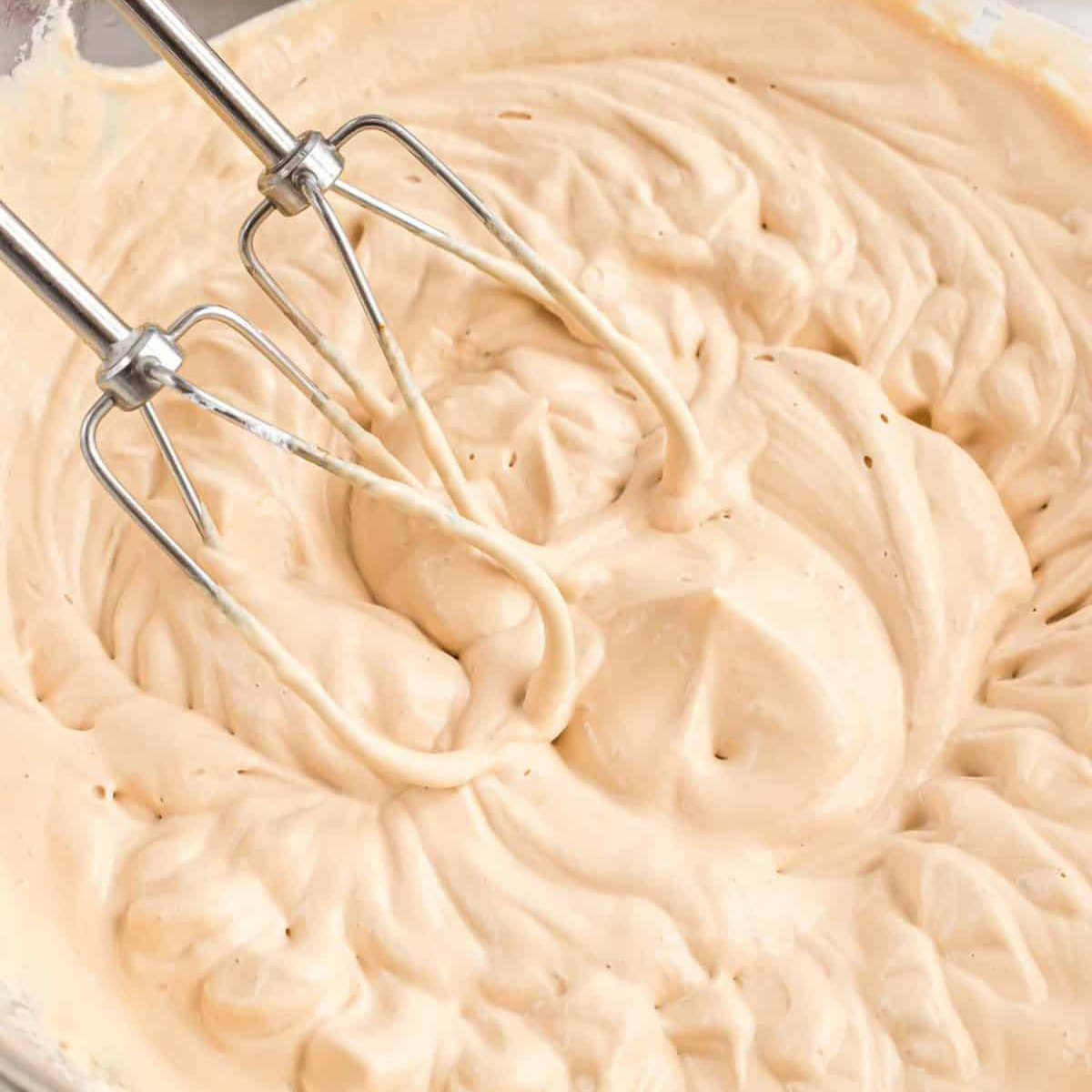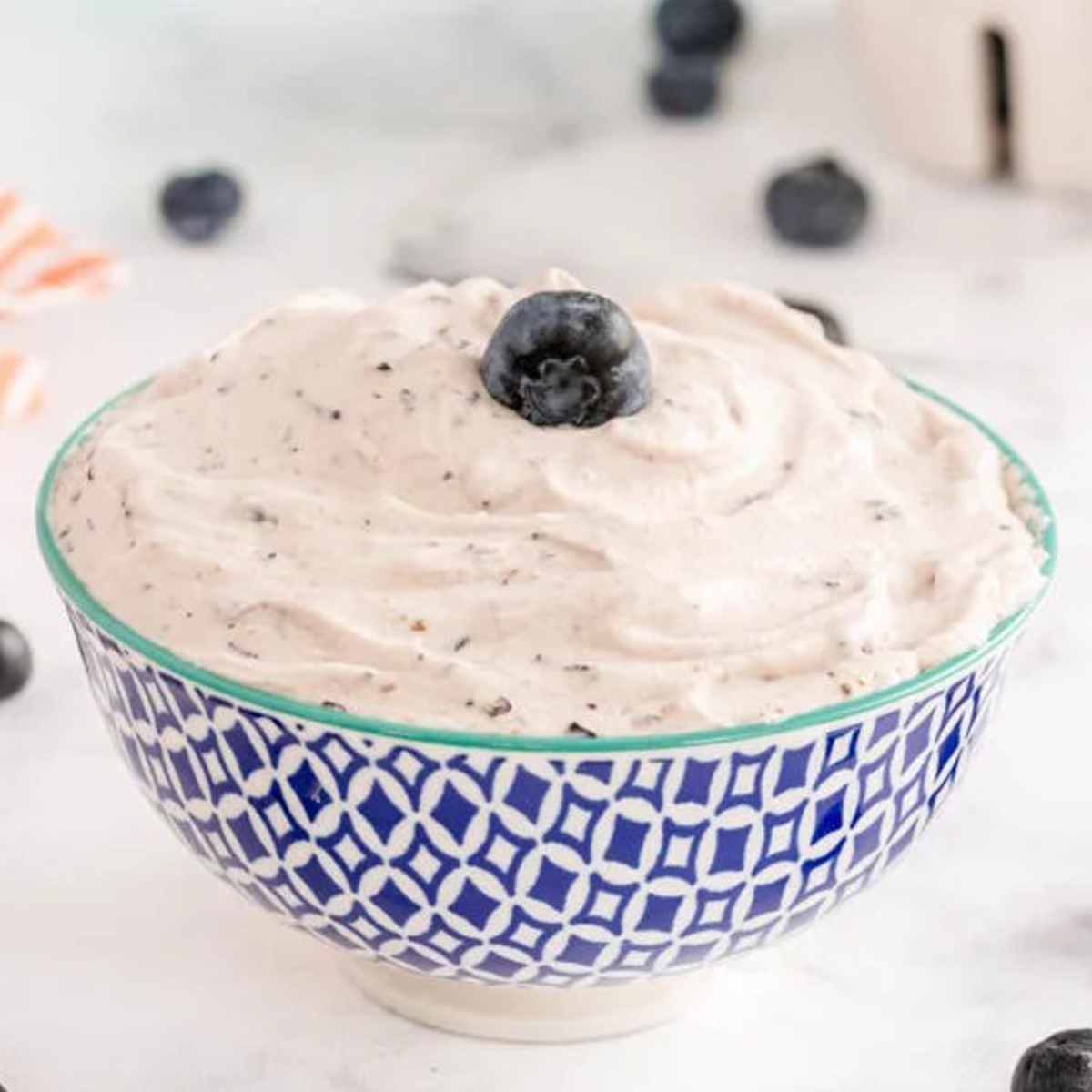Stabilized Whipped Cream, a culinary marvel, transforms ordinary whipped cream into a versatile and enduring topping that retains its airy texture and luscious flavor over time. Whipped cream, beloved for its delicate richness, has the tendency to deflate and lose its structure swiftly. Enter stabilized whipped cream—a technique that introduces stability to this classic indulgence, making it a dependable companion for a myriad of desserts. By incorporating stabilizing agents such as gelatin or cornstarch, this velvety topping gains the ability to hold its form, resist wilting, and decorate sweets with finesse. From adorning pies and cakes to filling pastries and trifles, stabilized whipped cream strikes the perfect balance between ephemeral delight and lasting elegance, enhancing the culinary journey with each delectable bite.

What is Stabilized Whipped Cream?
Stabilized whipped cream is a variation of traditional whipped cream that has been modified to maintain its texture and shape for a longer period of time. Regular whipped cream, made by whipping heavy cream until it forms soft peaks, is light and airy but tends to deflate and lose its structure relatively quickly. Stabilized whipped cream addresses this issue by incorporating stabilizing agents that help maintain the cream’s volume and texture over time.
There are several methods to stabilize whipped cream, and some common stabilizing agents include:
- Gelatin: Gelatin is dissolved in a small amount of warm water and then added to the whipped cream as it begins to thicken. The gelatin forms a network that helps the whipped cream hold its shape.
- Cornstarch: Cornstarch is mixed with a small amount of cold milk or cream and then heated until it thickens into a smooth paste. This paste is then incorporated into the whipped cream, providing stability.
- Cream Cheese: Adding a small amount of cream cheese to the whipped cream can also help stabilize it and add a subtle tanginess.
- Powdered Sugar: Some recipes stabilize whipped cream by using powdered sugar instead of granulated sugar. The cornstarch in powdered sugar contributes to the cream’s stability.
Stabilized whipped cream is commonly used for decorating cakes, pies, and other desserts where a longer-lasting, firmer texture is desired. It’s particularly useful in situations where desserts will be displayed for an extended period or when intricate piping and designs are involved.
While stabilized whipped cream offers improved longevity, it’s important to note that it may have a slightly different taste and mouthfeel compared to traditional whipped cream. The stabilizing agents can alter the cream’s natural flavor and texture to some extent. However, when used appropriately, stabilized whipped cream remains a valuable tool for bakers and dessert enthusiasts looking to elevate their creations while maintaining the visual appeal and lightness of regular whipped cream.

Why you will love Stabilized Whipped Cream?
Stabilized whipped cream offers a range of benefits that make it a favorite among bakers, dessert enthusiasts, and anyone seeking to elevate their sweet creations. Here’s why you might find yourself falling in love with stabilized whipped cream:
1. Prolonged Texture: Unlike traditional whipped cream, which can deflate and lose its volume quickly, stabilized whipped cream maintains its airy texture and shape for a longer period of time. This means you can decorate desserts in advance without worrying about the cream wilting.
2. Decorative Versatility: Stabilized whipped cream provides the ideal canvas for intricate piping, garnishes, and designs on cakes, cupcakes, pies, and other desserts. Its ability to hold its shape opens up creative possibilities for visually stunning presentations.
3. Make-Ahead Convenience: Stabilized whipped cream allows you to prepare desserts in advance, saving you time on the day of serving. This is particularly useful when planning for parties, celebrations, or events.
4. Light and Fluffy: Just like traditional whipped cream, stabilized whipped cream maintains its lightness and fluffiness. It adds a delicate touch to desserts without overwhelming them with heaviness.
5. Versatile Flavor: Stabilized whipped cream can be customized with various flavorings, extracts, or infusions to complement the flavors of different desserts. From vanilla and chocolate to citrus and fruit extracts, the possibilities are endless.
6. Enhanced Stability: When used as a frosting or filling, stabilized whipped cream provides stability to layered desserts. It holds its form even when stacked, ensuring each slice is as beautiful as the next.
7. Professional Presentation: Stabilized whipped cream allows you to achieve professional-looking results without the need for extensive baking and decorating skills. Even beginners can create elegant dessert presentations.
8. Playful Aesthetics: Stabilized whipped cream adds a touch of elegance to desserts while maintaining a playful and approachable appearance. Its creamy texture invites indulgence.
9. Lighter Alternative: Compared to buttercream or heavy frostings, stabilized whipped cream offers a lighter option that complements a wide range of desserts without overwhelming the palate.
10. Unique Flair: Utilizing stabilized whipped cream showcases your dedication to both taste and aesthetics. It’s an opportunity to bring a special touch to your desserts and surprise your guests with its longevity and appeal.
Incorporating stabilized whipped cream into your dessert repertoire allows you to create visually stunning and flavorful treats that delight the senses. Its versatility and longevity make it an invaluable tool in the world of baking, and experimenting with this technique can open up a world of creative possibilities in the realm of sweets.

Stabilized Whipped Cream Recipe
Ingredients:
- 1 teaspoon unflavored gelatin powder
- 4 teaspoons cold water
- 1 cup heavy whipping cream, chilled
- 1/4 cup powdered sugar
- 1 teaspoon vanilla extract (optional)
Instructions:
- Bloom the Gelatin:
- In a small bowl, sprinkle the gelatin over the cold water. Allow it to sit and absorb the water for about 5 minutes. This process is called blooming.
- Dissolve the Gelatin:
- After blooming, gently heat the gelatin mixture in the microwave for about 5-10 seconds or until the gelatin is fully dissolved. Be careful not to overheat.
- Prepare the Whipping Cream:
- Place the heavy whipping cream in a mixing bowl. You can chill the bowl and beaters in the refrigerator for about 15 minutes before starting.
- Whip the Cream:
- Using an electric mixer or a stand mixer fitted with the whisk attachment, start whipping the cream on low speed. Gradually increase the speed to medium-high as the cream thickens.
- Add Sugar and Vanilla:
- While the cream is still soft and billowy, gradually add the powdered sugar. Continue to whip until the cream begins to form soft peaks.
- If using vanilla extract, add it at this stage and continue whipping until the cream reaches firm peaks. Do not overwhip.
- Incorporate Gelatin:
- With the mixer running on low speed, slowly pour the dissolved gelatin into the whipped cream. Make sure the gelatin is evenly distributed throughout the cream.
- Whip Until Stiff:
- Increase the mixer speed to medium-high and continue whipping until the cream reaches stiff peaks. The cream should hold its shape well.
- Check Consistency:
- Stop whipping as soon as the cream reaches the desired consistency. Overwhipping can result in a grainy texture.
- Use or Store:
- Use the stabilized whipped cream immediately to decorate your desserts, or store it in an airtight container in the refrigerator. Stabilized whipped cream can be kept in the refrigerator for a day or two.
Note: Remember that stabilized whipped cream, while more stable than regular whipped cream, will not last indefinitely. It’s best to use it within a day or two for the best texture and flavor.
This formula creates stabilized whipped cream that is perfect for decorating cakes, cupcakes, pies, and other desserts while maintaining its structure and lightness over time.

How to serve Stabilized Whipped Cream
Serving stabilized whipped cream involves showcasing its airy texture and complementing the flavors of your desserts. Here’s how to serve stabilized whipped cream in an appealing and delightful manner:
- Choose the Right Desserts: Stabilized whipped cream is a versatile topping that works well with various desserts. Consider using it to adorn cakes, cupcakes, pies, tarts, trifles, parfaits, and fruit salads.
- Preparation: Before serving, ensure that your stabilized whipped cream is stored in the refrigerator to maintain its texture. If it has been refrigerated, you may need to give it a gentle whisk or stir to bring back its fluffiness.
- Piping and Decorating: If you’ve prepared the stabilized whipped cream with the intention of decorating your desserts, load it into a piping bag fitted with your desired tip. You can create swirls, rosettes, dollops, or other decorative patterns.
- Garnishes: Consider adding complementary garnishes to enhance the visual appeal. Fresh fruits, chocolate shavings, crushed nuts, edible flowers, or a dusting of cocoa or powdered sugar can elevate the presentation.
- Layered Desserts: For layered desserts like trifles or parfaits, alternate layers of desserts with layers of stabilized whipped cream. This creates a visually appealing and decadent treat.
- Temperature: Serve desserts topped with stabilized whipped cream at a slightly chilled or cool temperature. This enhances the overall dining experience and contrasts with the creamy topping.
- Serving Utensils: Provide appropriate utensils for serving, such as dessert forks, spoons, or dessert plates. Stabilized whipped cream is often light and airy, making it easy to scoop or cut.
- Portion Sizes: Pay attention to portion sizes when serving desserts with stabilized whipped cream. The light texture allows for generous portions without overwhelming guests.
- Variety: Experiment with different flavors of stabilized whipped cream by incorporating extracts, infusions, or even a touch of cocoa for a chocolate version. Match the flavors to the dessert for a harmonious combination.
- Visual Appeal: Arrange desserts with stabilized whipped cream on elegant dessert plates, cake stands, or individual serving dishes. The visual presentation adds to the anticipation and enjoyment.
- Last-Minute Topping: For certain desserts, you can add stabilized whipped cream just before serving to maintain its freshness and texture. This is particularly helpful when serving delicate items like mousse.
- Spoonfuls of Joy: Encourage your guests to indulge by providing a generous dollop of stabilized whipped cream on the side. The creamy, airy texture is often irresistible.
Remember that serving stabilized whipped cream isn’t just about taste; it’s about creating a multisensory experience that delights the eyes and palate alike. Whether used as a decorative touch or a generous topping, stabilized whipped cream adds a touch of elegance and a layer of lusciousness to your desserts.

How to store Stabilized Whipped Cream
Storing stabilized whipped cream properly is essential to maintain its texture and quality over time. Here’s how to store stabilized whipped cream to ensure it remains stable and ready for use:
- Refrigeration: Stabilized whipped cream should always be stored in the refrigerator. The cool temperature helps preserve its structure and prevent spoilage.
- Airtight Container: Transfer the stabilized whipped cream into an airtight container before refrigerating. Choose a container that is appropriately sized to prevent excess air exposure.
- Labeling: If you’ve prepared multiple batches or flavors of stabilized whipped cream, label the container with the date of preparation to help you keep track of freshness.
- Top Layer Protection: To further protect the whipped cream, place a layer of plastic wrap directly on the surface of the cream before sealing the container. This minimizes air contact, which can cause drying.
- Use Clean Utensils: Always use clean, dry utensils when scooping or serving stabilized whipped cream from the container. Avoid introducing moisture or contaminants that can affect its quality.
- Avoid Overstorage: Stabilized whipped cream is not immune to changes in texture over time. While it remains stable for longer than regular whipped cream, it’s still best to use it within a day or two for optimal taste and texture.
- Layered Desserts: If you’ve used stabilized whipped cream to layer desserts like trifles or parfaits, cover the entire dessert container with plastic wrap or a lid before refrigerating.
- Gelatin-Based Stabilization: If your stabilized whipped cream was stabilized using gelatin, you might notice a slight gelatinous texture after refrigeration. This is normal and will soften once you start using or whipping the cream again.
- Preventing Absorption of Odors: Stabilized whipped cream can absorb odors from other foods in the refrigerator. Store it away from strong-smelling items and foods with strong aromas.
- Whisking Before Use: If the stabilized whipped cream has thickened in the refrigerator, give it a gentle whisk or stir before use to restore its fluffiness.
- Freezing (Optional): While stabilized whipped cream can be refrigerated for short-term storage, freezing is not recommended. The texture and stability might be compromised after thawing, leading to changes in consistency.
- Single-Use Portions: If you plan to use the stabilized whipped cream for a specific occasion, consider storing it in portion-sized containers for easy serving.
By following these storage tips, you can enjoy the benefits of stabilized whipped cream for a longer period while maintaining its light and airy texture. Always prioritize freshness and hygiene when handling and storing whipped cream to ensure a delightful experience when it’s time to use it.
If You Love This Recipe Try These Out!
- Fluffy Chocolate Whipped Cream
- Tempting Berry Whipped Cream Delight
- Irresistible Coffee Whipped Cream
- Coconut Whipped Cream Paradise
- Luscious Vanilla Bean Whipped Cream
Tips to make perfect Stabilized Whipped Cream
Creating perfect stabilized whipped cream involves a combination of technique, precision, and attention to detail. Here are some tips to help you achieve the best results:
1. Choose Quality Ingredients: Use high-quality heavy whipping cream, as the fat content affects the stability and texture of the whipped cream.
2. Chilled Equipment: Chill the mixing bowl, beaters, or whisk attachment in the refrigerator for about 15-20 minutes before whipping. Cold equipment helps the cream whip faster and hold its structure better.
3. Measure Accurately: Measure ingredients accurately to maintain the right balance between cream and stabilizers. Precision is key to achieving the desired consistency.
4. Dissolve Gelatin Properly: If using gelatin, ensure it’s fully dissolved and smooth before adding it to the whipped cream. Avoid over-heating the gelatin mixture.
5. Gradual Sugar Incorporation: When adding powdered sugar, do so gradually to avoid clumps. Adding it too quickly can lead to uneven distribution and affect stability.
6. Soft Peaks to Stiff Peaks: Whip the cream until it reaches stiff peaks. Be cautious not to overwhip, as it can lead to a grainy texture.
7. Add Flavoring Gently: If using flavorings like vanilla extract, add them gently after the cream starts to thicken. Over-mixing after adding flavorings can affect stability.
8. Incorporate Stabilizers Gradually: Whether using gelatin, cornstarch, or another stabilizer, add it gradually while whipping. This ensures even distribution and prevents clumping.
9. Don’t Rush the Process: Avoid rushing the whipping process. Start on low speed and gradually increase to medium-high as the cream thickens.
10. Stop When Stiff Peaks Form: Stop whipping as soon as the cream reaches stiff peaks. Overwhipping can cause the cream to become curdled or grainy.
11. Consistent Texture: Maintain a consistent texture throughout the whipped cream. This ensures that the stabilizer is well distributed and prevents lumps.
12. Avoid Overstorage: While stabilized whipped cream lasts longer than regular whipped cream, it’s still best to use it within a day or two for optimal texture and flavor.
13. Gentle Mixing After Refrigeration: If the stabilized whipped cream thickens in the refrigerator, give it a gentle stir or whisk to restore its fluffiness before using.
14. Experiment and Adjust: Depending on the stabilizer used, you might need to adjust quantities and methods slightly to achieve your desired results.
15. Practice Patience: Whipping cream takes time, and the process can vary based on factors like cream temperature and equipment. Be patient and attentive throughout the whipping process.
Perfecting stabilized whipped cream requires practice and a keen eye for texture and consistency. Adjust your technique based on the specific stabilizer you use and the desired outcome. With patience and attention to detail, you can achieve beautifully stabilized whipped cream that enhances the presentation and taste of your desserts.

FAQ’s
Certainly! Here are some frequently asked questions (FAQs) and troubleshooting tips related to stabilized whipped cream:
1. Why is my stabilized whipped cream runny?
- If your stabilized whipped cream is runny, it could be due to insufficient whipping or over-stabilization. Ensure that you whip the cream until stiff peaks form, but be cautious not to overwhip. Additionally, make sure you’ve used the appropriate stabilizer in the correct ratio.
2. My stabilized whipped cream has a grainy texture. What went wrong?
- Grainy texture can result from overwhipping the cream. Once the cream reaches stiff peaks, stop whipping immediately. Overwhipping causes the fat molecules to break down, resulting in a curdled or grainy appearance.
3. Can I use stabilized whipped cream for piping intricate designs?
- Yes, stabilized whipped cream is excellent for piping intricate designs due to its stability. However, practice piping on a separate surface before decorating your dessert to become familiar with the cream’s consistency.
4. Can I freeze desserts topped with stabilized whipped cream?
- While stabilized whipped cream holds up better than regular whipped cream, freezing can affect its texture. Desserts with stabilized whipped cream are best enjoyed fresh or after refrigeration, as freezing and thawing may alter its lightness and stability.
5. How long can I store stabilized whipped cream in the refrigerator?
- Stabilized whipped cream can be stored in the refrigerator for about a day or two. While it maintains its structure longer than regular whipped cream, it’s still best to use it within a reasonable time frame to ensure the best texture and flavor.
6. Can I use flavored extracts in stabilized whipped cream?
- Yes, you can use flavored extracts like vanilla, almond, or citrus to enhance the taste of stabilized whipped cream. Add these extracts after the cream starts to thicken and adjust the quantity to taste.
7. Can I stabilize whipped cream without gelatin or cornstarch?
- Yes, you can stabilize whipped cream using other methods. Some alternatives include using cream of tartar, instant pudding mix, or stabilized cream cheese. Each method might have slightly different effects on taste and texture, so experiment to find the best fit for your needs.
8. Why does my stabilized whipped cream have a gelatinous texture after refrigeration?
- If you’ve used the gelatin method to stabilize the whipped cream, you might notice a slightly gelatinous texture after refrigeration. This is normal and will soften when the cream is whipped again or allowed to come to room temperature.
9. Can I re-whip stabilized whipped cream after refrigeration?
- Yes, you can re-whip stabilized whipped cream after refrigeration to restore its fluffiness. Use a gentle whisk or mixer on low speed until the cream reaches the desired consistency.
10. Can I use stabilized whipped cream as a substitute for heavy cream in recipes?
- Stabilized whipped cream may not perform the same way as heavy cream in recipes that require liquid heavy cream, such as soups or sauces. It’s best to use heavy cream in such cases.
Remember that practice and experimentation are key to mastering stabilized whipped cream. If you encounter issues, don’t be discouraged; troubleshooting helps you learn and improve your technique for future creations.
Nutrition information
Stabilized whipped cream is primarily made from heavy whipping cream and possibly a stabilizing agent. Since the stabilizing agents are typically used in small quantities and contribute minimal calories and nutrients, the nutritional content of stabilized whipped cream is mainly determined by the heavy whipping cream. Here’s a general estimate of the nutritional information for stabilized whipped cream made from 1 cup of heavy whipping cream:
Nutrition Information for 1 Cup of Stabilized Whipped Cream:
- Calories: Approximately 800-900 calories
- Total Fat: About 80-90g
- Saturated Fat: About 50-60g
- Cholesterol: Around 300mg
- Sodium: Less than 50mg
- Total Carbohydrates: Less than 10g
- Dietary Fiber: 0g
- Sugars: Less than 1g
- Protein: About 5g
Please note that these values are rough estimates and can vary based on the specific brand and type of heavy whipping cream used. Stabilized whipped cream is rich in calories and saturated fat due to its high cream content. While it adds a delightful touch to desserts, it’s important to enjoy it in moderation as part of a balanced diet.


